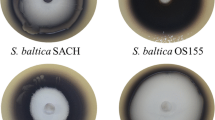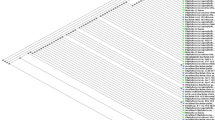Abstract
The recovery of tellurium as an important rare metal from wastes and wastewater must be promoted to satisfy its increasing demand for use in many industries. For development of a biological process for recovering tellurium from wastewater, three bacterial strains capable of reducing soluble tellurite into insoluble elemental tellurium were isolated from the drainage wastewater of a metal refinery plant. The bacterial strains, Stenotrophomonas maltophilia TI-1, Ochrobactrum anthropi TI-2 and O. anthropi TI-3, resisted up to 30 mM tellurite, and removed 86–89 % of 1 mM tellurite from water phase within 21 h in a reductive reaction. They showed a considerably higher tellurite removal rate than the previously reported tellurite-reducing bacteria. Tellurite-reducing activity was observed at 20–40 °C, pH 6.2–8.5 and 0.05–5 % NaCl (0.1 mM/h at maximum). The tellurite-reducing activities of strains TI-2 and TI-3 were not considerably different from each other, however strain TI-1 showed higher tellurite-reducing activity at low temperatures, low pH and high NaCl concentrations than the other strains. Because deposits of elemental tellurium were formed on and free from the bacterial cells, it is possible to recover tellurium from the water phase by centrifugation, ultrafiltration, or coagulation following tellurite reduction. All bacterial strains isolated in this study are inferred to be great candidates to establish bacterial tellurium recovery processes from industrial wastewater containing high concentrations of tellurite.







Similar content being viewed by others
References
U.S. Geological Survey, Mineral commodity summaries 2011: U.S. Geological Survey, 164 p. (http://minerals.usgs.gov/minerals/pubs/mcs/2011/mcs2011.pdf) (2011)
Woodhouse, M., Goodrich, A., Margolis, R., James, T., Dhere, R., Gessert, T., Barnes, T., Eggert, R., Albin, D.: Perspectives on the pathways for cadmium telluride photovoltaic module manufacturers to address expected increases in the price for tellurium. Solar Energy Mat. Solar Cells (in press)
Taylor, D.E.: Bacterial tellurite resistance. Trends Microbiol. 7, 111–115 (1999)
Chasteen, T.G., Fuentes, D.E., Tantalean, J.C., Vasquez, C.C.: Tellurite: history, oxidative stress, and molecular mechanisms of resistance. FEMS Microbiol. Rev. 33, 820–832 (2009)
Kobayashi, A., Ogra, Y.: Metabolism of tellurium, antimony and germanium simultaneously administered to rats. J. Toxicol. Sci. 34, 295–303 (2009)
Summers, A.O., Jacoby, G.A.: Plasmid-determined resistance to tellurium compounds. J. Bacteriol. 129, 276–281 (1977)
Ollivier, P.R.L., Bahrou, A.S., Church, T.M., Hanson, T.E.: Aeration controls the reduction and methylation of tellurium by the aerobic, tellurite-resistant marine yeast Rhodotorula mucilaginosa. Appl. Environ. Microbiol. 77, 4610–4617 (2011)
Ollivier, P.R.L., Bahrou, A.S., Marcus, S., Cox, T., Church, T.M., Hanson, T.E.: Volatilization and precipitation of tellurium by aerobic tellurite-resistant marine microbes. Appl. Environ. Microbiol. 74, 7163–7173 (2008)
Rathgeber, C., Yurkova, N., Stackebrandt, E., Beatty, J.T., Yurkov, V.: Isolation of tellurite- and selenite-resistant bacteria from hydrothermal vents of the Juan de Fuca Ridge in the Pacific Ocean. Appl. Environ. Microbiol. 68, 4613–4622 (2002)
Summers, A.O., Silver, S.: Microbial transformations of metals. Ann. Rev. Microbiol. 32, 637–672 (1978)
Rajwade, J.M., Paknikar, K.M.: Bioreduction of tellurite to elemental tellurium by Pseudomonas mendocina MCM B-180 and its practical application. Hydrometallurgy 71, 243–248 (2003)
Kuroda, M., Notaguchi, E., Sato, A., Yoshioka, M., Hasegawa, A., Kagami, T., Narita, T., Yamashita, M., Sei, K., Soda, S., Ike, M.: Characterization of Pseudomonas stutzeri NT-I capable of removing soluble selenium from the aqueous phase under aerobic conditions. J. Biosci. Bioeng. 112, 259–264 (2011)
Soda, S., Kashiwa, M., Kagami, T., Kuroda, M., Yamashita, M., Ike, M.: Laboratory-scale bioreactors for soluble selenium removal from selenium refinery wastewater using anaerobic sludge. Desalination 279, 433–438 (2011)
Cowan, S.T., Steel, K.J.: Cowan and Steel’s manual for the identification of medical bacteria, 2nd edn. Cambridge University Press, Cambridge (1974)
Sambrook, J., Russell, D.W.: Molecular cloning: A laboratory manual, 3rd edn. Cold Spring Harbor Laboratory Press, Cold Spring Harbor (2001)
Altschul, S.F., Gish, W., Miller, W., Myers, E.W., Lipman, D.J.: Basic local alignment search tool. J. Mol. Biol. 215, 403–410 (1990)
Turner, R.J., Weiner, J.H., Taylor, D.E.: Use of diethyldithiocarbamate for quantitative determination of tellurite uptake by bacteria. Anal. Biochem. 204, 292–295 (1992)
Basnayake, R.S.T., Bius, J.H., Akpolat, O.M., Chasteen, T.G.: Production of dimethyl telluride and elemental tellurium by bacteria amended with tellurite or tellurate. Appl. Organomet. Chem. 15, 499–510 (2001)
Swearingen Jr, J.W., Araya, M.A., Plishker, M.F., Saavedra, C.P., Vasquez, C.C., Chasteen, T.G.: Identification of biogenic organotellurides in Escherichia coli K-12 headspace gases using solid-phase microextraction and gas chromatography. Anal. Biochem. 331, 106–114 (2004)
Sepahei, A.A., Rashetnia, V.: Tellurite resistance and reduction during aerobic and anaerobic growth of bacteria isolated from Sarcheshmeh copper mine. Iran. J. Environ. Health Sci. Eng. 6, 253–260 (2009)
Amoozegar, M.A., Ashengroph, M., Malekzadeh, F., Razavi, M.R., Naddaf, S., Kabiri, M.: Isolation and initial characterization of the tellurite reducing moderately halophilic bacterium, Salinicoccus sp. strain QW6. Microbiol. Res. 163, 456–465 (2008)
Moore, M.D., Kaplan, S.: Identification of intrinsic high-level resistance to rare-earth oxides and oxyanions in members of the class Proteobacteria: characterization of tellurite, selenite, and rhodium sesquioxide reduction in Rhodobacter sphaeroides. J. Bacteriol. 174, 1505–1514 (1992)
Yamada, A., Miyagishima, N., Matsunaga, T.: Tellurite removal by marine photosynthetic bacteria. J. Mar. Biotechnol. 5, 46–49 (1997)
Yurkov, V., Jappe, J., Vermeglio, A.: Tellurite resistance and reduction by obligately aerobic photosynthetic bacteria. Appl. Environ. Microbiol. 62, 4195–4198 (1996)
Pages, D., Rose, J., Conrod, S., Cuine, S., Carrier, P., Heulin, T., Achouak, W.: Heavy metal tolerance in Stenotrophomonas maltophilia. PLoS One 2, e1539 (2008)
Chien, C.C., Han, C.T.: Tellurite resistance and reduction by a Paenibacillus sp. isolated from heavy metal-contaminated sediment. Environ. Toxicol. Chem. 28, 1627–1632 (2009)
George, M.W.: Selenium and tellurium. U. S. geological survey minerals yearbook (http://minerals.usgs.gov/minerals/pubs/commodity/selenium/selenmyb03.pdf) (2003)
Cournoyer, B., Watanabe, S., Vivian, A.: A tellurite-resistance genetic determinant from phytopathogenic pseudomonads encodes a thiopurine methyltransferase: evidence of a widely conserved family of methyltransferases. Biochim. Biophys. Acta 1397, 161–168 (1998)
Lloyd-Jones, G., Ritchie, D.A., Strike, P.: Biochemical and biophysical analysis of plasmid pMJ600-encoded tellurite [TeO3 2−] resistance. FEMS Microbiol. Lett. 81, 19–24 (1991)
Lloyd-Jones, G., Osborn, A.M., Ritchie, D.A., Strike, P., Hobman, J.L., Brown, N.L., Rouch, D.A.: Accumulation and intracellular fate of tellurite in tellurite-resistant Escherichia coli: A model for the mechanism of resistance. FEMS Microbiol. Lett. 118, 113–120 (1994)
Turner, R.J., Weiner, J.H., Taylor, D.E.: Neither reduced uptake nor increased efflux is encoded by tellurite resistance determinants expressed in Escherichia coli. Can. J. Microbiol. 41, 92–98 (1995)
Zannoni, D., Borsetti, F., Harrison, J.J., Turner, R.J.: The bacterial response to the chalcogen metalloids Se and Te. Adv. Microb. Physiol. 53, 1–71 (2008)
Tucker, F.L., Walper, J.F., Appleman, M.D., Donohue, J.: Complete reduction of tellurite to pure tellurium metal by microorganisms. J. Bacteriol. 83, 1313–1314 (1962)
Kashiwa, M., Nishimoto, S., Takahashi, K., Ike, M., Fujita, M.: Factors affecting soluble selenium removal by a selenate-reducing bacterium Bacillus sp. SF-1. J. Biosci. Bioeng. 89, 528–533 (2000)
Baesman, S.M., Stolz, J.F., Kulp, T.R., Oremland, R.S.: Enrichment and isolation of Bacillus beveridgei sp. nov., a facultative anaerobic haloalkaliphile from Mono Lake, California, that respires oxyanions of tellurium, selenium, and arsenic. Extremophiles 13, 695–705 (2009)
Chien, C.C., Jiang, M.H., Tsai, M.R., Chien, C.C.: Isolation and characterization of and environmental cadmium- and tellurite-resistant Pseudomonas strain. Environ. Toxicol. Chem. 30, 2202–2207 (2011)
Di Tomaso, G., Fedi, S., Carnevali, M., Manegatti, M., Taddei, C., Zannoni, D.: The membrane-bound respiratory chain of Pseudomonas pseudoalcaligenes KF707 cells grown in the presence or absence of potassium tellurite. Microbiology 148, 1699–1708 (2002)
Slobodkina, G.B., Bonch-Osmolovskaya, E.A., Slobodkin, A.I.: Reduction of chromate, selenite, tellurite, and iron (III) by the moderately thermophilic bacterium Bacillus thermoamylovorans SKC1. Microbiology 76, 530–534 (2007)
Klevay, L.M.: Pharmacology and toxicology of heavy metals: tellurium. Pharmacol. Therapeut. 1, 223–229 (1976)
Bruzzoniti, M.C., Mentasti, E., Sarzanini, C., Cavalli, S.: Behaviour of selenium and tellurium species and their determination by ion chromatography. Chromatographia 46, 49–56 (1997)
Ministry of the Environment: Youchousakoumokutoutyousamanual: Suishitsu, teishitsu,suiseiseibutu). Ministry of the Environment, Tokyo (http://www.env.go.jp/water/chosa/h15-03.pdf) (2003)
Soda, S., Takahashi, H., Kagami, T., Miyake, M., Notaguchi, E., Sei, K., Iwasaki, N., Ike, M.: Biotreatment of selenium refinery wastewater using pilot-scale granular sludge and swim-bed bioreactors augmented with a selenium-reducing bacterium Pseudomonas stutzeri NT-I. Jpn. J. Water Treat. Biol. 48, 63–71 (2012)
Acknowledgments
This study was partly supported by the Japan Securities Scholarship Foundation. We thank Mr. Hisamitsu Takahashi and Mr. Nobuo Iwasaki (Shinko Chemical Co. Ltd.) for providing water samples, and Mr. Akio Isono (Kansai Application Research Center, JEOL Ltd.) for his helpful advice related to SEM–EDX analysis.
Author information
Authors and Affiliations
Corresponding author
Rights and permissions
About this article
Cite this article
Kagami, T., Fudemoto, A., Fujimoto, N. et al. Isolation and Characterization of Bacteria Capable of Reducing Tellurium Oxyanions to Insoluble Elemental Tellurium for Tellurium Recovery from Wastewater. Waste Biomass Valor 3, 409–418 (2012). https://doi.org/10.1007/s12649-012-9145-3
Received:
Accepted:
Published:
Issue Date:
DOI: https://doi.org/10.1007/s12649-012-9145-3




